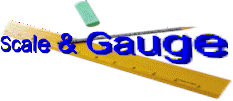

Anytime there is a reference to scale in any modeling context, it is in regards to how much smaller; and in a few cases, bigger, the model is relative to the prototype. It is expressed as a ratio, 1/25, for example. This means the model is twenty-five times smaller. Or looking at it another way, it would take twenty-five models to equal the length of the real item. This is further complicated by the fact that there are letter designations used in model railroading. The most common is "HO", scale wise 1/87.1. When the scale was first introduced, it was to be half the size of "O" (Half-O), and since "O" scale was 1/48th in size, HO technically should be 1/96th . As it’s roots were in Europe, some manufacturers used a metric conversion: one foot = 3.5mm. If one does the math, it turns out to be 1/87.1.
When referring to gauge, that is the distance between the insides of the rails. It has been standardized on the prototype to be four feet, eight and one-half inches. If measured in SCALE units, the gauge remains the same. But what does narrow gauge imply? It is any track that is laid to a distance less that the standard. HOn3 means the scale is still 1/87.1, but the distance between the rail is only three feet, and Sn2 ½ is 1/64th, with the track laid at two and a half feet apart.